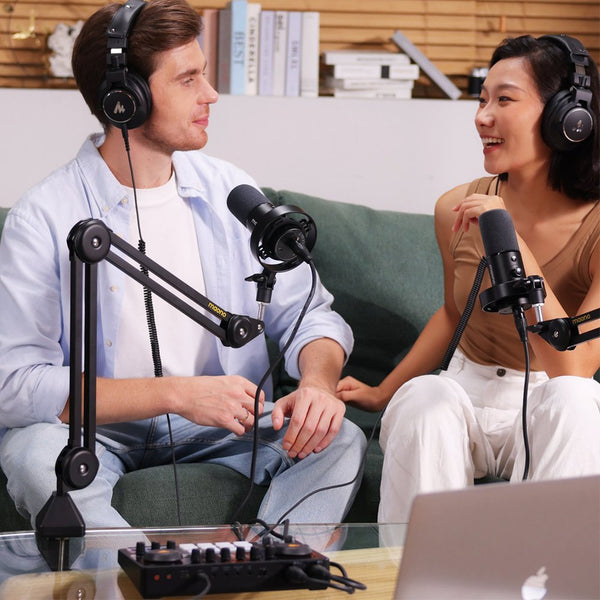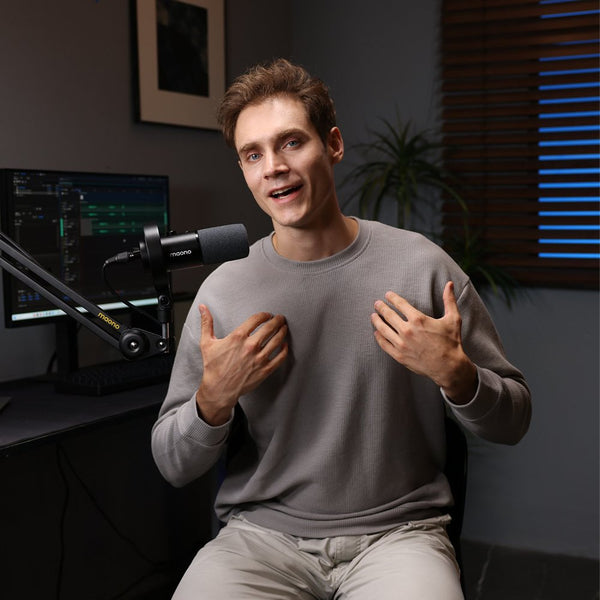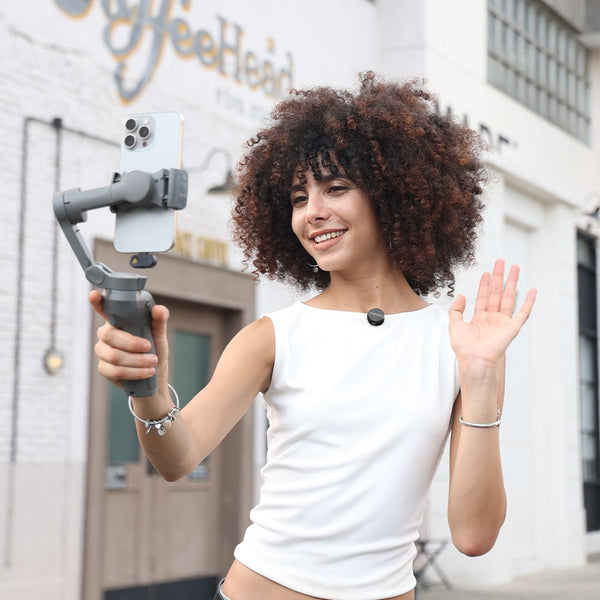Have you ever wondered if small, compact, and trendy wireless microphones can be used for voice acting? Normally, people use USB microphones or XLR mics for voice acting or voice-over projects. However, with the emergence of wireless microphones with built-in voice filters—and because they’re easy to use and portable—let’s find out if these can also be used for voice acting work.
Voice acting is a craft that demands clarity, consistency, and authenticity. Whether you're narrating an audiobook, voicing a character in a video game, or recording a commercial, your microphone choice can make or break the final product. Traditionally, wired XLR or USB microphones have dominated the voiceover industry. However, with recent advances in audio technology, wireless microphone options are increasingly entering the spotlight—especially for content creators and remote voice actors seeking flexibility.

Can I use a wireless microphone for voice acting at home?
Yes, you absolutely can. Wireless microphones are no longer limited to live stage performances or field reporting. Today’s wireless mic systems, particularly digital ones, offer high-resolution sound, stable connections, and enough features to support semi-professional and professional voice acting projects from the comfort of your home studio.
Is the audio quality of wireless mics good enough for voice overs?
Modern wireless microphones can deliver excellent audio quality, rivaling some of the best wired alternatives. However, not all wireless mics are built the same, and selecting the right one is key. Some entry-level models may compromise on frequency response or latency, which could affect your vocal recording. That said, brands like Maono, Shure, and Sennheiser are producing wireless solutions tailored to creators, including those involved in voiceover work—especially those seeking a wireless collar mic for PC or mobile compatibility.
What are the pros and cons of using wireless vs USB mics for voice acting?
Pros of wireless microphones:
-
Freedom of movement
No cables to restrict positioning or create clutter.
-
Flexibility
Ideal for multi-tasking voice actors who record standing, gesturing, or even pacing for dynamic reads.
-
Portability
Great for remote work, outdoor environments, or non-traditional studios.
-
Clean setup
Less desk clutter and more ergonomic options for mic placement.
-
Wireless collar mic for camera
Compatibility makes these setups appealing for creators filming video alongside voice acting.
Cons of wireless microphones:
-
Potential latency
Some wireless systems introduce slight delays, although many modern mics offer ultra-low latency.
-
Battery dependence
Wireless mics require power, and battery life can limit long recording sessions.
-
Signal interference
Cheaper systems may pick up radio interference or drop the signal in certain conditions.
-
Higher cost
Some wireless setups are generally more expensive than USB microphones.
Pros of USB microphones:
-
Plug-and-play
No need for audio interfaces or receivers—just connect to your PC or Mac.
-
Affordability
Many high-quality USB mics are available under $100 (Check out Maono USB microphones)
-
Consistent sound quality
No signal loss or interference concerns.
-
Ideal for beginners
Simple to use with minimal setup.
Cons of USB microphones:
-
Limited mobility
You're tethered to your recording setup.
-
Fixed position
Usually mounted on a desktop stand or boom arm.
-
Less modular
USB mics often lack interchangeable parts like capsules or external preamps.
How do I ensure consistent mic positioning with a wireless setup?
One of the challenges in voice acting is maintaining a consistent distance and angle between your mouth and the microphone to avoid uneven volume or tonal shifts. With wireless lavalier or clip-on mics, placement on your clothing can vary—resulting in fluctuations in audio quality.
To improve consistency:
-
Use a universal lapel microphone or lavalier clip near the center of your chest, about 6–8 inches from your mouth.
-
Use a headset mic if you prefer head-mounted consistency, particularly in animated or character-heavy performances.
-
Monitor your recordings with headphones to identify inconsistent takes early.
-
Consider a wireless handheld mic on a boom arm if you want more control over positioning while still enjoying cable-free operation.
Can wireless mics be used for remote or mobile voice acting gigs?
Absolutely. Wireless mics shine in mobile and remote environments. Whether you're recording on-location for a commercial or traveling for freelance work, wireless microphones can adapt easily without the need to carry heavy audio gear. Many come with portable transmitters and compact receivers compatible with laptops, tablets, or even smartphones—making them ideal for recording voice overs on the go.
In fact, using a lav mic with iPhone or using a lav mic with iPhone setups are becoming increasingly popular for on-the-go content creation and voice acting.
Battery life and connectivity are essential here. Look for systems that offer:
-
Long battery life (at least 6–9 hours)
-
USB-C charging
-
Dual-channel options for interviews or multi-voice recordings
-
Smartphone adapters for mobile recording
Check out Maono Wave T5 for having these features listed above.
Do any professional voice actors use wireless microphones?
While most top-tier voice actors prefer wired XLR studio microphones for critical work due to the utmost quality and reliability, wireless microphones are increasingly used in certain professional contexts, especially for:
-
Live dubbing and ADR (Automated Dialogue Replacement) on film sets
-
On-the-go commercial voice work
-
Virtual live performances
-
Podcasting and live streaming with character voices
Wireless systems are also favored by YouTubers and TikTok creators who blend voice acting with video content, as the mobility adds to their expressive delivery—especially when using a wireless collar mic for camera to match both audio and visual content effectively.
What features should I look for in a wireless mic for voice acting?
When choosing a wireless microphone for voice acting, consider the following must-have features:
-
High-resolution audio (48kHz/24-bit or better)
-
Low latency (<10 ms)
-
Stable wireless transmission (2.4 GHz or UHF)
-
Wide frequency response (ideally 20Hz–20kHz)
-
Low self-noise (below 20 dBA)
-
Adjustable gain control
-
Windscreen or Windproof included
-
Compatibility with PCs, Macs, and mobile devices
-
Battery life of 6+ hours
-
Digital noise reduction/noise cancellation or DSP features
How do I connect a wireless mic to my computer for voice over work?
Wireless microphones usually come with a receiver that can be connected to your computer via:
-
USB-A or USB-C (most common and plug-and-play)
-
3.5mm TRS jack (for audio interfaces or headphone ports)
-
XLR output (for professional-grade audio interfaces)
For voice actors, the most convenient setup is a USB receiver that’s recognized as an audio input by your DAW (Digital Audio Workstation) such as Audacity, Adobe Audition, or Reaper.
Steps to connect:
-
Power on your wireless mic and receiver.
-
Plug the receiver into your computer.
-
Set the mic as the default recording input.
-
Open your DAW and test levels.
-
Record a few test lines to ensure there’s no interference or delay.
Which wireless mic is best for voice acting beginners?
For beginners seeking a balance between affordability, sound quality, and portability, the Maono Wave T5 wireless microphone is a fantastic option.
Why the Maono Wave T5?
-
Plug-and-play USB-C and Lightning compatibility
-
Professional-grade 48kHz/24-bit audio
-
Digital noise cancellation and gain adjustment
-
Ultra-lightweight clip-on design
-
Dual transmitters for multi-voice setups
-
Charging case included with up to 30 hours of battery life (with the charging case)
Whether you're auditioning for roles, recording character samples, or even live streaming, the Maono Wave T5 delivers clean, studio-quality audio with the freedom of wireless operation—perfect for voice actors on a budget or just getting started.
Conclusion
So, are wireless microphones good enough for voice acting? In many cases—yes, especially with today’s advancements in wireless audio technology. While traditionalists may still prefer wired mics like USB and XLR mics for critical studio work, modern wireless microphones offer a compelling blend of mobility, convenience, and surprisingly high audio fidelity.
For beginners, wireless mics like the Maono Wave T5 offer a solid stepping stone into the world of voice acting, delivering excellent performance without the complexity of bulky interfaces or cables. For experienced voice actors, wireless systems serve as valuable tools for remote gigs, live readings, or mobile recording.
The key is to match your microphone choice with your recording environment, budget, and specific use cases. Whether you're standing at a desk or recording lines from a makeshift booth while traveling, there's a wireless mic out there that fits your voice acting workflow.
In the end, it’s not just about the gear—it’s about how well you use it to bring characters, stories, and emotions to life. With the right wireless microphone—whether it's a wireless collar mic for PC, a universal lapel microphone, or using a lav mic with iPhone—your voice can carry professionalism and personality, cable-free.



